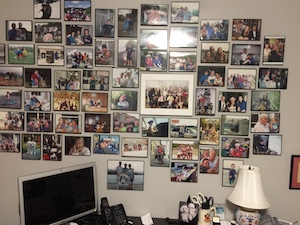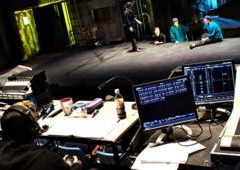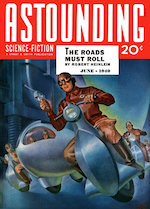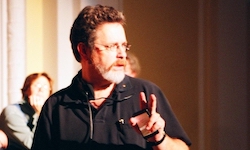 Have you ever wondered what’s behind the conflict between geeks and suits? Sure, they think differently, but what, exactly, does that mean? A Jesuit priest who passed away in 2003 at the age of 90 may hold one clue.
Have you ever wondered what’s behind the conflict between geeks and suits? Sure, they think differently, but what, exactly, does that mean? A Jesuit priest who passed away in 2003 at the age of 90 may hold one clue.
Walter Ong published a slim volume in 1982 titled “Orality and Literacy: The Technologizing of the Word†that explored what the differences between oral and literate cultures suggest about how we think.
Remember Homer, the blind epic poet credited with “The Iliad” and “The Odyssey”? If we remember anything, it’s something along the lines of someone who managed to memorize and then flawlessly recite book-length poems for his supper.
The real story, which Ong details, is more interesting and more relevant to our organizational world than you might suspect. Homer sits at the boundary between oral culture and the first literate cultures.
In an oral culture, what you can think is limited to what you can remember and tell—without visual aids. Ong’s work shows that oral thinking is linear, additive, redundant, situational, engaged, and conservative. The invention of writing and the emergence of literate cultures allows a new kind of thinking to develop: literate thinking is subordinate, analytic, objectively distanced, and abstract. It’s the underlying engine of science and the industrial revolution.
While this may be interesting for a college bull session, it’s particularly relevant to organizations. For all their dependence on the industrial revolution, organizations are human institutions first. Management is fundamentally an oral culture and is most comfortable with thought organized that way. Historically, leadership in organizations went to those most facile with the spoken word.
At the opposite extreme, information technology is a quintessentially literate activity with a literate mode of thought. In fact, IT cannot exist without the objective, rational, analytical thinking that literate culture enables.
How does the nature of this divide complicate conversations between IT and management? Can understanding the differing natures of oral and literate thought help us bridge that divide?
IT professionals have long struggled with getting a complex message across to management. In our honest and unguarded moments, we talk of “dumbing it down for the suits.†But the challenge is more subtle than that. We need to repackage the argument to work within the frame of oral thought. The easy part of that is about oratorical and rhetorical technique. The more important challenge is to deal with the deeper elements of oral culture; of being situational, engaged, and conservative. The right abstract answer can’t be understood until it is placed carefully within its context.
What management recognizes in its fundamentally oral mind is that organizations and their inhabitants spend most of their time in oral modes of thought. The oral mind is focused on tradition and stability because of how long it takes to embed a new idea. The techniques of change management that seem so obtuse to the literate, engineering mind are not irrational; they are oral. They are the necessary steps to embed new ideas and practices in oral minds.
Repeating a calculation or an analysis is nonsense in a literate culture. Management objections to an analytical proposal rarely turn on objections to the analysis. Walking through the analysis again at a deeper level of detail will not help. What needs to be done is to craft the oral culture story that will carry the analytical tale. It’s not about dumbing down an argument, it’s about repackaging it to match the fundamental thought processes of the target audience.
That might mean finding the telling anecdote or designating an appropriate hero or champion. Suppose, for example, that your analysis concludes it’s time to move toward document management to manage the files littering a shared drive somewhere or buried as attachments to three-year old e-mails. Analytical statistics on improved productivity won’t do it. A scenario of the “day in the life†of a field sales rep would be better. Best would be a story of the sales manager who can’t find the marked up copy of the last version of the contract.
These human stories are much more than the tricks of the trade of consultants and sales reps. They are recognition that what gets dressed up as the techniques of change management are really a bridge to the oral thinking needed to provoke action.
Seen in this light, what is typically labeled resistance to change is better understood as the necessary time and repetition to embed ideas in an oral mind.
Management understands something that those rooted in literate thinking may not. Knowing the right answer analytically has little or nothing to do with whether you can get the organization to accept that answer. What literate thinkers dismiss as “politics†is the essential work of translating and packaging an idea for acceptance and consumption in an oral culture.
The critical step in translating from a literate answer to an oral plan of action is finding a story to hang the answer on. The analysis only engages the mind; moving analysis to action must engage the whole person. Revealing this truth to the analytical minded can be discomforting. It’s equivalent to explaining to an accountant that the key to a Capital Expenditure proposal is theater, not economics. You might want to check out Steve Denning’s book, “The Springboard: How Storytelling Ignites Action in Knowledge-Era Organizations,†for some good insights into how to craft effective stories inside organizations.
In addition to helping the analytically inclined see the value of creating a compelling story, you need to help them see how and why story works differently than analysis. The best stories to drive change are not complex, literary, novels. They are epic poetry; tapping into archetypes and cliché, acknowledging tradition, grounded in the particular. You need to bring them to an understanding of why repetition and “staying on message†is key to shifting an oral culture’s course, not an evil invention of marketing.
Assume you teach the literate types in your IT organization how to repackage their analyses for consumption. They’ve now learned how to pitch their ideas in ways that will stick in the organization. What might you learn from their literate approach to thought? Is there an opportunity if you can get more of your organization and more of your management operating with literate modes of thinking?
Being able to write things down done permits you to develop an argument that is more complex and sophisticated. On the plus side, this makes rocket science possible. On the negative side, you get lawyers.
On the other hand, if you are operating in an environment whose complexity demands a corresponding complexity in your organizational responses, then encouraging more literate thinking by more members of the organization is a good strategy.
What would such an organization look like compared to today’s dominant oral design? The mere presence of e-mail and an intranet is insufficient. E-mail tends to mirror oral modes of thought, particularly among more senior executives. Intranets tend to be over-controlled and, to the extent they contain examples of literate thinking, are rooted in an organizational culture that strives to confine the literate mind to the role of well-pigeonholed expert. The presence of particular tools, then, isn’t likely to be a good predictor, although their absence might be.
What of possible case examples? A few knowledge management success stories hold hints. Buckman Labs used discussion groups successfully to get greater leverage out of its staff’s knowledge and expertise. Whether this success built on literate modes of thought or simply on better distribution of oral stories is less clear. The successes of some widely distributed software development teams are worth looking at from this perspective.
Although it’s a bit too early to tell, the take up of blogs and wikis inside organizations may be a harbinger of management based on literate thinking skills. They offer an interesting bridge between the oral and the literate by providing a way to capture conversation in a way that makes it visible and, hence, analyzable. As a class of tools, they begin to move institutional memory out of the purely oral and into the realm of literate.

 I’ve talked about the
I’ve talked about the  On days that I teach, I take the train into Chicago and then walk from Ogilvie Station up to the Loyola Watertower campus. Generally takes me about 30 minutes. Yesterday, as I was mulling over what to write here, I came to an intersection. The “Don’t Walk†sign was lit and several other pedestrians were waiting patiently. I looked both ways, saw that there was no oncoming traffic, and continued on my way.
On days that I teach, I take the train into Chicago and then walk from Ogilvie Station up to the Loyola Watertower campus. Generally takes me about 30 minutes. Yesterday, as I was mulling over what to write here, I came to an intersection. The “Don’t Walk†sign was lit and several other pedestrians were waiting patiently. I looked both ways, saw that there was no oncoming traffic, and continued on my way. I remember my parents as being light drinkers. One beer at a Saturday barbecue would be typical. I never thought too much about it, even as my peers began their introductions to alcohol.
I remember my parents as being light drinkers. One beer at a Saturday barbecue would be typical. I never thought too much about it, even as my peers began their introductions to alcohol. My mom’s been gone for almost sixteen years now. I still marvel at how she managed to wrangle seven kids between the ages of 8 and 1. I recall one conversation about reading when my boys were young. I was the absolutely stereotypical bookworm. Getting my first library card at the age of 10 still ranks among my signal memories. On a recent visit to my home town, I actually stopped at the local library simply to thank the librarians for existing.
My mom’s been gone for almost sixteen years now. I still marvel at how she managed to wrangle seven kids between the ages of 8 and 1. I recall one conversation about reading when my boys were young. I was the absolutely stereotypical bookworm. Getting my first library card at the age of 10 still ranks among my signal memories. On a recent visit to my home town, I actually stopped at the local library simply to thank the librarians for existing. “Julie! It’s 10th grade algebra!â€
“Julie! It’s 10th grade algebra!â€ Developing an interest in the interplay between technology and organizations isn’t something you know is going to happen when you’re in middle school. There’s no teacher or coach to emulate. There’s no hero’s quest to set out on. But there have to be roots.
Developing an interest in the interplay between technology and organizations isn’t something you know is going to happen when you’re in middle school. There’s no teacher or coach to emulate. There’s no hero’s quest to set out on. But there have to be roots. The place where technology, organizations, and people come together has been a continuing focus of my work. That interest was birthed in stories of the wonders and dangers of fantastic new inventions. Like a lot of future scientists and engineers I was raised on the stories of Isaac Asimov, Arthur C . Clarke, and Robert Heinlein.
The place where technology, organizations, and people come together has been a continuing focus of my work. That interest was birthed in stories of the wonders and dangers of fantastic new inventions. Like a lot of future scientists and engineers I was raised on the stories of Isaac Asimov, Arthur C . Clarke, and Robert Heinlein. Have you ever wondered what’s behind the conflict between geeks and suits? Sure, they think differently, but what, exactly, does that mean? A Jesuit priest who passed away in 2003 at the age of 90 may hold one clue.
Have you ever wondered what’s behind the conflict between geeks and suits? Sure, they think differently, but what, exactly, does that mean? A Jesuit priest who passed away in 2003 at the age of 90 may hold one clue.